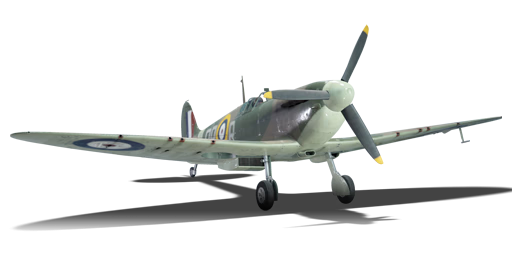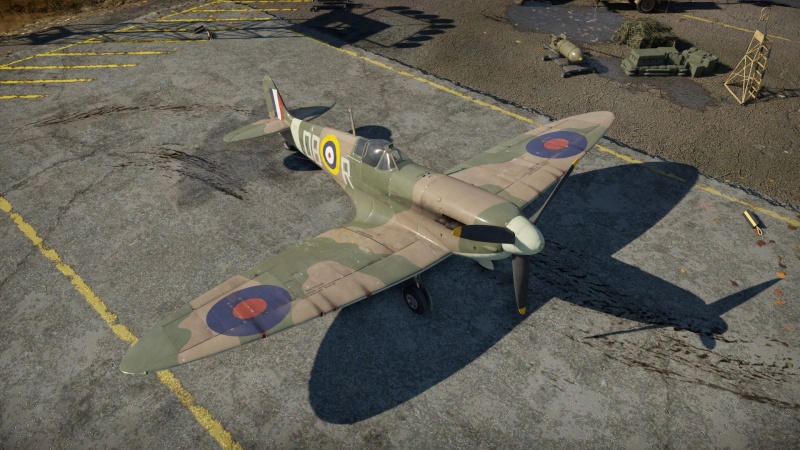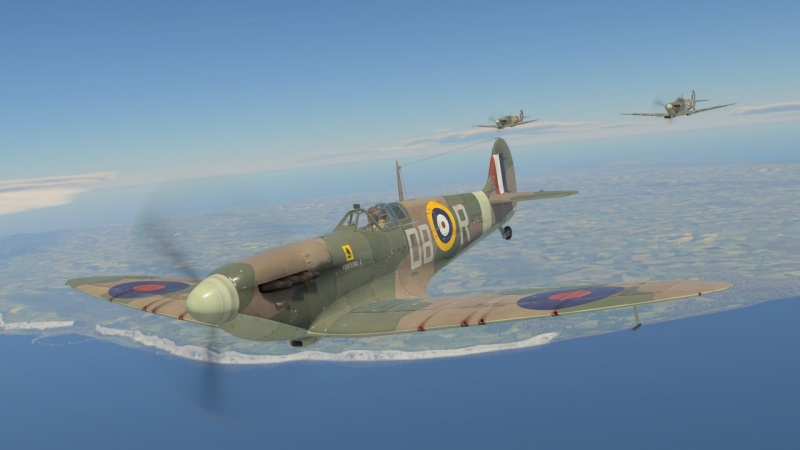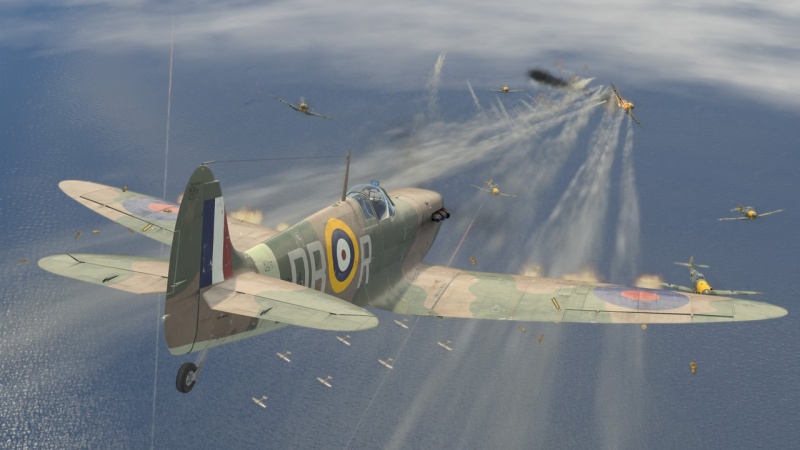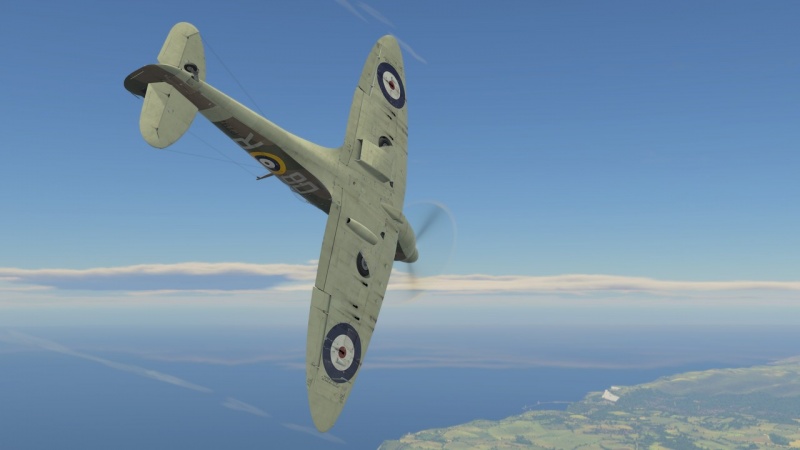Difference between revisions of "Spitfire Mk.IIa Venture I"
(Added store images to top of page) |
Toxicwaste23 (talk | contribs) (→Usage in battles) (Tag: Visual edit) |
||
| Line 106: | Line 106: | ||
* 8 x 7.7 mm Browning machine guns, wing-mounted (350 rpg = 2,800 total) | * 8 x 7.7 mm Browning machine guns, wing-mounted (350 rpg = 2,800 total) | ||
| + | |||
The Spitfire has a relatively good ammo count but the 4-digit ammo can be deceiving, since there are 8 guns on the aircraft. These should be primarily used against aircraft but can also be used as last resort to attack light or non-armoured ground targets, usually with stealth or universal belts. The job should be left to dedicated gun platforms like the Hurricanes and the Hellcats. | The Spitfire has a relatively good ammo count but the 4-digit ammo can be deceiving, since there are 8 guns on the aircraft. These should be primarily used against aircraft but can also be used as last resort to attack light or non-armoured ground targets, usually with stealth or universal belts. The job should be left to dedicated gun platforms like the Hurricanes and the Hellcats. | ||
| Line 112: | Line 113: | ||
;Combat tactics | ;Combat tactics | ||
| + | |||
The Spitfire Mk.IIa Venture I is an excellent low to medium altitude dogfighter. Lacking a supercharger, it shouldn't be used at high altitudes. In Air RB, it's best to climb to around 3500-4000 meters (11,500-13,200 feet) where the Merlin XII engine performs optimally. After climbing, release WEP and reduce throttle to below 95% to cool the engine until you've found a target. When engaging opponents, diving should be carefully executed to avoid speeds of 450 KM/H (280 MP/H) or greater, where control surfaces begin to suddenly stiffen. In combat, the light airframe and powerful engine provides a respectable rate of climb and an incredibly tight turning circle, combined with its eight browning machine guns, it is capable of eliminating enemy targets in short, controlled bursts. Poor weapon management will deplete your 2,800 rounds of ammunition quickly because individually, the machine guns are not very powerful. Concentrate and aim for the engine, cockpit or wings where your bullets will be most efficient at destroying vital components, such as wing spars or control surfaces. | The Spitfire Mk.IIa Venture I is an excellent low to medium altitude dogfighter. Lacking a supercharger, it shouldn't be used at high altitudes. In Air RB, it's best to climb to around 3500-4000 meters (11,500-13,200 feet) where the Merlin XII engine performs optimally. After climbing, release WEP and reduce throttle to below 95% to cool the engine until you've found a target. When engaging opponents, diving should be carefully executed to avoid speeds of 450 KM/H (280 MP/H) or greater, where control surfaces begin to suddenly stiffen. In combat, the light airframe and powerful engine provides a respectable rate of climb and an incredibly tight turning circle, combined with its eight browning machine guns, it is capable of eliminating enemy targets in short, controlled bursts. Poor weapon management will deplete your 2,800 rounds of ammunition quickly because individually, the machine guns are not very powerful. Concentrate and aim for the engine, cockpit or wings where your bullets will be most efficient at destroying vital components, such as wing spars or control surfaces. | ||
| Line 119: | Line 121: | ||
;Enemies worth noting | ;Enemies worth noting | ||
| + | |||
* Zeroes: They can outmanoeuvre the Spitfire in a turnfight. | * Zeroes: They can outmanoeuvre the Spitfire in a turnfight. | ||
* Bf 109: They can inflict tremendous damage if you don't watch out. They have quite good turning performance and their energy retention exceeds that of the Spitfire. | * Bf 109: They can inflict tremendous damage if you don't watch out. They have quite good turning performance and their energy retention exceeds that of the Spitfire. | ||
| Line 165: | Line 168: | ||
== History == | == History == | ||
| − | + | In the summer of 1939 an early Mk I ''K9788'' was fitted with a new version of the Merlin, the XII. With the success of the trial it was decided to use this version of the Merlin in the Mk II which, it was decided, would be the first version to be produced exclusively by the huge new Lord Nuffield shadow factory at Castle Bromwich. | |
| − | '' | + | |
| + | Chief among the changes was the upgraded 1,175 horsepower (876 kW) Merlin XII engine. This engine included a Coffman engine starter, instead of the electric system of earlier and some later versions of the Merlin, and it required a small "teardrop" blister on the forward starboard cowling. The Merlin XII was cooled by a 70% to 30% water glycol mix, rather than pure glycol used for earlier Merlin versions. | ||
| + | |||
| + | In early 1940 Spitfire Is of 54 and 66 Squadrons were fitted with Rotol manufactured wide-bladed propellers of 10 ft 9 in (3.27 m) diameter, which were recognisable by a bigger, more rounded spinner: the decision was made that the new propeller would also be used exclusively by the Mk II. This engine/propeller combination increased top speed over the late Mk I by about 6–7 mph below 17,000 feet (5,200 m), and improved climb rate. Due to all of the weight increases maximum speed performance was still lower than that of early Mk Is, but combat capability was far better. The Mk II was produced in '''IIa''' eight-gun and '''IIb''' cannon armed versions. Deliveries were very rapid, and they quickly replaced all remaining Mk Is in service, which were then sent to Operational Training Units. The RAF had re-equipped with the new version by April 1941. The Rotol propeller units were later supplemented by de Havilland constant-speed units similar to those fitted to Mk Is. | ||
| + | |||
| + | A small number of Mk IIs were converted to "Long Range" Spitfires in early 1941. These could be recognised by the fixed 40 gal (182 L) fuel tank which was fitted under the port wing. With a full tank manoeuvrability was reduced, maximum speed was 26 mph (42 km/h) lower and the climb rate and service ceiling were also reduced. Several squadrons used this version to provide long-range bomber escort. Once the Mk II was taken out of front line service, 50 of them were converted for air-sea rescue work, at first under the designation '''Mk IIc (type 375)''' but later referred to as the ASR Mk II. The Merlin XII was replaced by the Mark XX, a "rescue pack" was fitted in the flare chute and smoke marker bombs were carried under the port wing. | ||
| + | |||
| + | A total of 921 Mk IIs were built, all by Castle Bromwich. A small number of Mk IIs were converted to Mk Vs. | ||
=== In-game description === | === In-game description === | ||
| Line 179: | Line 189: | ||
;Skins | ;Skins | ||
| + | |||
* [https://live.warthunder.com/feed/camouflages/?vehicleCountry=britain&vehicleType=aircraft&vehicleClass=fighter&vehicle=spitfiremkiia_ep Skins and camouflages for the {{PAGENAME}} from live.warthunder.com.] | * [https://live.warthunder.com/feed/camouflages/?vehicleCountry=britain&vehicleType=aircraft&vehicleClass=fighter&vehicle=spitfiremkiia_ep Skins and camouflages for the {{PAGENAME}} from live.warthunder.com.] | ||
| Line 190: | Line 201: | ||
;Related development | ;Related development | ||
| + | |||
* [[Spitfire (Family)]] | * [[Spitfire (Family)]] | ||
Revision as of 07:44, 5 February 2022
| This page is about the premium British fighter Spitfire Mk.IIa Venture I. For other versions, see Spitfire (Family). |
Contents
Description
The Spitfire Mk.IIa Venture I is a premium rank II British fighter with a battle rating of 2.7 (AB) and 3.0 (RB/SB). It was introduced in Update "Starfighters".
General info
Flight performance
| Characteristics | Max Speed (km/h at 4,572 m) |
Max altitude (metres) |
Turn time (seconds) |
Rate of climb (metres/second) |
Take-off run (metres) | |||
|---|---|---|---|---|---|---|---|---|
| AB | RB | AB | RB | AB | RB | |||
| Stock | 545 | 535 | 10000 | 16.1 | 16.5 | 14.0 | 16.0 | 300 |
| Upgraded | 599 | 571 | 14.8 | 15.1 | 27.3 | 19.4 | ||
Details
| Features | ||||
|---|---|---|---|---|
| Combat flaps | Take-off flaps | Landing flaps | Air brakes | Arrestor gear |
| X | X | ✓ | X | X |
| Limits | ||||||
|---|---|---|---|---|---|---|
| Wings (km/h) | Gear (km/h) | Flaps (km/h) | Max Static G | |||
| Combat | Take-off | Landing | + | - | ||
| 760 | 270 | N/A | N/A | 230 | ~11 | ~6 |
| Optimal velocities (km/h) | |||
|---|---|---|---|
| Ailerons | Rudder | Elevators | Radiator |
| < 321 | < 400 | < 350 | > 500 |
| Compressor | Optimal altitude | 100% Engine power | WEP Engine power |
|---|---|---|---|
| Setting 1 | 4,490 m | 1,140 hp | 1,311 hp |
Survivability and armour
- 38 mm Bulletproof glass in cockpit front.
- 4 mm Steel plate in pilot's seat.
- 6-7 mm Steel plate behind the pilot.
Modifications and economy
Armaments
Offensive armament
The Spitfire Mk.IIa Venture I is armed with:
- 8 x 7.7 mm Browning machine guns, wing-mounted (350 rpg = 2,800 total)
The Spitfire has a relatively good ammo count but the 4-digit ammo can be deceiving, since there are 8 guns on the aircraft. These should be primarily used against aircraft but can also be used as last resort to attack light or non-armoured ground targets, usually with stealth or universal belts. The job should be left to dedicated gun platforms like the Hurricanes and the Hellcats.
Usage in battles
- Combat tactics
The Spitfire Mk.IIa Venture I is an excellent low to medium altitude dogfighter. Lacking a supercharger, it shouldn't be used at high altitudes. In Air RB, it's best to climb to around 3500-4000 meters (11,500-13,200 feet) where the Merlin XII engine performs optimally. After climbing, release WEP and reduce throttle to below 95% to cool the engine until you've found a target. When engaging opponents, diving should be carefully executed to avoid speeds of 450 KM/H (280 MP/H) or greater, where control surfaces begin to suddenly stiffen. In combat, the light airframe and powerful engine provides a respectable rate of climb and an incredibly tight turning circle, combined with its eight browning machine guns, it is capable of eliminating enemy targets in short, controlled bursts. Poor weapon management will deplete your 2,800 rounds of ammunition quickly because individually, the machine guns are not very powerful. Concentrate and aim for the engine, cockpit or wings where your bullets will be most efficient at destroying vital components, such as wing spars or control surfaces.
Defensively, it's most susceptible to experienced Bf-109 pilots who know not to engage early model Spitfires in turning engagements. When forced in an energy fight or outnumbered, reduce the altitude of your opponents and fly towards your team. Use your roll rate and tight turning radius to avoid enemy fire whenever possible. The plane is capable shaking enemy fire due to its nimbleness. If no teammates are around, force the enemy to be low and slow, use your superior turn and roll-rate with flaps to get the edge. This includes against Japanese aircraft. Zeroes are the only contemporary capable of turning with this Spitfire, use your flaps and manage your engine throttle carefully, rolling scissors is an excellent manoeuvre to get the edge against light Japanese fighters.
Landing the Spitfire Mk.IIa Venture I is easy, the plane doesn't like to give up speed easily, so roll 90 degrees left and right banking low and hard to reduce speed. Once around 200 KM/H (125 MP/H), deploy your landing gear to perform a fast landing. Flaps are unnecessary unless making an emergency landing.
- Enemies worth noting
- Zeroes: They can outmanoeuvre the Spitfire in a turnfight.
- Bf 109: They can inflict tremendous damage if you don't watch out. They have quite good turning performance and their energy retention exceeds that of the Spitfire.
- Heavy Bombers: Although the Spitfire Mk IIa is armed with 8 guns, they are only 7.7 mm in calibre. So, it can be difficult to destroy heavy fighters, attackers, and especially bombers. It is likely that long bursts will be necessary to destroy such targets, and that gives time for enemy turret gunners to shoot back. Luckily, most bombers at this tier are not defended by turrets from all angles. Try to plan attack runs so that you don't fly in the enemy's line of fire.
Manual Engine Control
| MEC elements | ||||||
|---|---|---|---|---|---|---|
| Mixer | Pitch | Radiator | Supercharger | Turbocharger | ||
| Oil | Water | Type | ||||
| Controllable | Controllable Not auto controlled |
Not controllable Not auto controlled |
Controllable Not auto controlled |
Separate | Not controllable 1 gear |
Not controllable |
Pros and cons
Pros:
- Eight 7.7 mm machine guns provide great anti-fighter power
- Great turn rate
- Good roll rate at low speed
- Better-than-average top speed
- Great rate of climb
- Better engine power than Spitfire Mk Ia
- Decent amount of armour, a front 38 mm glass and rear 4-7 mm steel plates
Cons:
- Machine guns only effective if the target is hit in continuous bursts
- Machine gun armament lacks the long range hitting power of cannons
- Ammo can run out quickly in prolonged, uncontrolled bursts
- Quick kills against large bombers without a pilot snipe is difficult, prolonged engagements expose the Spitfire to the defensive gunners
- Machine guns cannot penetrate heavily armoured targets
- Bad high altitude performance
- Roll rate stiffens dramatically at ~350 km/h
- Pulling negative G's and rolling the plane (Realistic/simulator only) can cause the carburettor (engine) to fail
History
In the summer of 1939 an early Mk I K9788 was fitted with a new version of the Merlin, the XII. With the success of the trial it was decided to use this version of the Merlin in the Mk II which, it was decided, would be the first version to be produced exclusively by the huge new Lord Nuffield shadow factory at Castle Bromwich.
Chief among the changes was the upgraded 1,175 horsepower (876 kW) Merlin XII engine. This engine included a Coffman engine starter, instead of the electric system of earlier and some later versions of the Merlin, and it required a small "teardrop" blister on the forward starboard cowling. The Merlin XII was cooled by a 70% to 30% water glycol mix, rather than pure glycol used for earlier Merlin versions.
In early 1940 Spitfire Is of 54 and 66 Squadrons were fitted with Rotol manufactured wide-bladed propellers of 10 ft 9 in (3.27 m) diameter, which were recognisable by a bigger, more rounded spinner: the decision was made that the new propeller would also be used exclusively by the Mk II. This engine/propeller combination increased top speed over the late Mk I by about 6–7 mph below 17,000 feet (5,200 m), and improved climb rate. Due to all of the weight increases maximum speed performance was still lower than that of early Mk Is, but combat capability was far better. The Mk II was produced in IIa eight-gun and IIb cannon armed versions. Deliveries were very rapid, and they quickly replaced all remaining Mk Is in service, which were then sent to Operational Training Units. The RAF had re-equipped with the new version by April 1941. The Rotol propeller units were later supplemented by de Havilland constant-speed units similar to those fitted to Mk Is.
A small number of Mk IIs were converted to "Long Range" Spitfires in early 1941. These could be recognised by the fixed 40 gal (182 L) fuel tank which was fitted under the port wing. With a full tank manoeuvrability was reduced, maximum speed was 26 mph (42 km/h) lower and the climb rate and service ceiling were also reduced. Several squadrons used this version to provide long-range bomber escort. Once the Mk II was taken out of front line service, 50 of them were converted for air-sea rescue work, at first under the designation Mk IIc (type 375) but later referred to as the ASR Mk II. The Merlin XII was replaced by the Mark XX, a "rescue pack" was fitted in the flare chute and smoke marker bombs were carried under the port wing.
A total of 921 Mk IIs were built, all by Castle Bromwich. A small number of Mk IIs were converted to Mk Vs.
In-game description
The Supermarine Spitfire was a British fighter which served with various nations from the late 1930s up into the 1950s. It was a single-engine, all-metal, low-wing monoplane with retractable landing gear. Various modifications served as fighters, interceptors, high-altitude fighters, fighter-bombers and reconnaissance aircraft. A total of some 20,300 Spitfires of all types were built during the war, including two-seater trainers.
In the summer of 1939, an early Spitfire Mk I was fitted with the new Rolls Royce Merlin XII engine, which had a higher output of 1175 HP and was fitted with a Coffman engine starter instead of the previous Merlin's electrical starter system. This, combined with the Rotol variable pitch propeller which had been used on many Spitfire Mk Is would now form the powerplant of the new Spitfire Mk II, although some production models used the De Havilland propeller. The Mk II was some 6-7 mph faster than the later Spitfire Mk I, but still slower than the original Spitfires before a series of modifications increased the aircraft's weight. As with the Mk I, the Spitfire Mk II was produced with either eight machine guns as the Spitfire Mk IIA, or two 20mm cannon and four machine guns as the Mk IIb. The earlier problems with cannon fitted to the Mk IB had now been solved by introducing a belt feed system to the weapon to replace the earlier drum, turning the cannon on its side and fitting a blister on the wing to house the new mechanism.
920 Spitfire Mk IIs entered service; 750 Mk IIA and 170 MK IIB, although fighters used in the air-sea rescue role were later designated Mk IIC. The Spitfire II quickly replaced the Spitfire I, with the older variant being relegated to use in Operational Training Units. By April 1941, RAF Fighter Command had completed re-equipping with the Mk II, although this too would soon be replaced by the Mk V.
Media
- Skins
- Videos
See also
- Related development
External links
| Supermarine | |
|---|---|
| Spitfires | |
| Merlin engine | Spitfire Mk Ia · Spitfire Mk IIa · Spitfire Mk.IIa Venture I · Spitfire Mk IIb |
| Spitfire Mk Vb · Spitfire Mk Vb/trop · Spitfire Mk Vc · Spitfire Mk Vc/trop | |
| Spitfire F Mk IX · Spitfire F Mk IXc · Spitfire F Mk XVI | |
| Spitfire LF Mk IX · Plagis' Spitfire LF Mk IXc | |
| Griffon engine | Spitfire F Mk XIVc · Spitfire F Mk XIVe · Prendergast's Spitfire FR Mk XIVe · Spitfire F Mk XVIIIe · Spitfire F Mk 22 · Spitfire F Mk 24 |
| Export | ▄Spitfire Mk Vb/trop · ▃Spitfire LF Mk IXc · ▂Spitfire Mk IXc · Spitfire Mk IXc · Spitfire Mk.IX (CW) · Weizman's Spitfire LF Mk.IXe · ▄Spitfire FR Mk XIVe |
| Seafires | Seafire LF Mk.III · Seafire F Mk XVII · Seafire FR 47 |
| Export | ▄Seafire LF Mk.III |
| Jet fighters | Attacker FB 1 · Attacker FB.2 · Scimitar F Mk.1 · Swift F.1 · Swift F.7 |
| Hydroplanes | Walrus Mk.I |
| Britain premium aircraft | |
|---|---|
| Fighters | Tuck's Gladiator Mk II · ▄Boomerang Mk I · ▄Boomerang Mk II · ▄D.520 |
| ▄Martlet Mk IV · ▄Corsair F Mk II · ▄Hellcat Mk II · ▄Thunderbolt Mk.1 · ▄Mustang Mk IA | |
| Hurricane Mk.I/L FAA M · Spitfire Mk.IIa Venture I · Spitfire F Mk IXc · Plagis' Spitfire LF Mk IXc · Spitfire F Mk XIVc · Prendergast's Spitfire FR Mk XIVe | |
| Typhoon Mk Ib · MB.5 | |
| Twin-engine fighters | Hornet Mk.I · Whirlwind P.9 |
| Jet fighters | Attacker FB.2 · Hunter FGA.9 · Lightning F.53 · Meteor F Mk.8 Reaper · Sea Vixen F.A.W. Mk.2 · F-4J(UK) Phantom II · ▄MiG-21 Bison |
| Strike aircraft | ▄Wirraway · Beaufighter Mk I (40-mm) · Wyvern S4 |
| Harrier GR.1 · Strikemaster Mk.88 | |
| Bombers | ▄Avenger Mk II · ▄Boston Mk I · ▄Catalina Mk IIIa · ▄DB-7 · ▄Havoc Mk I · ▄Hudson Mk V · Swordfish Mk II |


